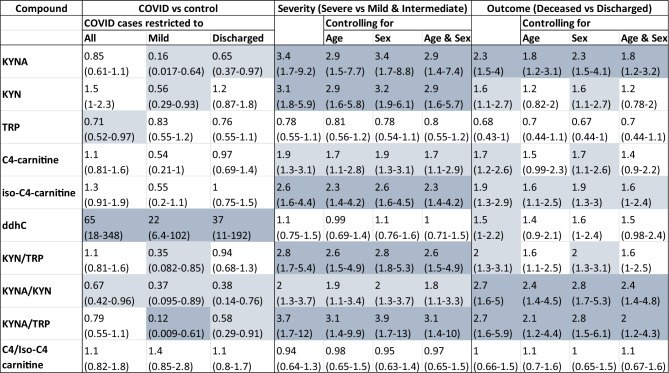Table 3.
Results from logistic regression comparing COVID-19 to control, severe cases to non-severe and deceased to discharged patients
All results are presented as OR and (90% CI). For severity and outcome age and sex corrected results are also included. Significance is established based on CI not crossing 1. Significant relationships with OR > 2 or < 0.5 are coloured in dark blue and significant relationship with smaller effect are coloured in light blue to support readability
Note the concentrations were scaled prior to analysis to support comparison between compounds. Mild COVID-19 patients’ group (n=28) and discharged COVID-19 patients’ group (n=72) were compared to control patients. All results are presented as ORs and 90% CIs. The strongest differentiator of COVID-19 cases vs. controls was the level of ddhC which, for most cases, is non-existent in control patients. In general, the mild and discharged patient population is quite comparable to the control population, despite significant logistic regression results indicating lower levels in mild COVID-19 cases e.g., KYNA, KYN, KYNA/TRP. As shown in the case for KYNA/TRP (SI Figure 15) those results are mainly influenced by outliers in the control population rather than general trends. In severity all compounds were significant except tryptophan and ddhC. When looking at the ratios KYNA/TRP ratio shows the strongest OR summarising the trends in the TRP degradation pathway. In outcome KYNA has the strongest relationship to poor outcome with KYNA/KYN ratios. Finally, C4 and iso-C4 carnitines show significance in severity and outcome, where age partially explains the relationship to outcome. No relation of the C4/iso-C4 ratio in COVID-19 severity or outcome was observed

